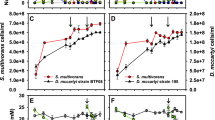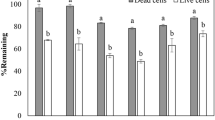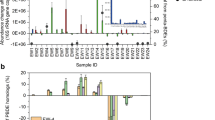Abstract
Benzene contamination is a significant problem. It is used in a wide range of manufacturing processes and is a primary component of petroleum-based fuels. Benzene is a hydrocarbon that is soluble, mobile, toxic and stable, especially in ground and surface waters. It is poorly biodegraded in the absence of oxygen. However, anaerobic benzene biodegradation has been documented under various conditions. Although benzene biomineralization has been demonstrated with nitrate1, Fe(III)2,3,4,5, sulphate6,7 or CO28,9 as alternative electron acceptors, these studies were based on sediments or microbial enrichments. Until now there were no organisms in pure culture that degraded benzene anaerobically. Here we report two Dechloromonas strains, RCB and JJ, that can completely mineralize various mono-aromatic compounds including benzene to CO2 in the absence of O2 with nitrate as the electron acceptor. This is the first example, to our knowledge, of an organism of any type that can oxidize benzene anaerobically, and we demonstrate the potential applicability of these organisms to the treatment of contaminated environments.
This is a preview of subscription content, access via your institution
Access options
Subscribe to this journal
Receive 51 print issues and online access
$199.00 per year
only $3.90 per issue
Buy this article
- Purchase on Springer Link
- Instant access to full article PDF
Prices may be subject to local taxes which are calculated during checkout





Similar content being viewed by others
References
Burland, S. M. & Edwards, E. A. Anaerobic benzene biodegradation linked to nitrate reduction. Appl. Environ. Microbiol. 65, 529–533 (1999).
Lovley, D. R., Woodward, J. C. & Chapelle, F. H. Stimulated anoxic biodegradation of aromatic hydrocarbons using Fe(III) ligands. Nature 370, 128–131 (1994).
Lovley, D. R., Woodward, J. C. & Chapelle, F. H. Rapid anaerobic benzene degradation with a variety of chelated Fe(III) forms. Appl. Environ. Microbiol. 62, 288–291 (1996).
Anderson, R. T. & Lovley, D. R. Naphthalene and benzene degradation under Fe(III)-reducing conditions in petroleum-contaminated aquifers. Bioremed. J. 3, 121–135 (1999).
Anderson, R. T., Rooney-Varga, J., Gaw, C. V. & Lovley, D. R. Anaerobic benzene oxidation in the Fe(III) reduction zone of petroleum-contaminated aquifers. Environ. Sci. Technol. 32, 1222–1229 (1998).
Lovley, D. R., Coates, J. D., Woodward, J. C. & Phillips, E. J. P. Benzene oxidation coupled to sulfate reduction. Appl. Environ. Microbiol. 61, 953–958 (1995).
Weiner, J. & Lovley, D. R. Anaerobic benzene degradation in petroleum-contaminated sediments after inoculation with a benzene-oxidizing enrichment. Appl. Environ. Microbiol. 64, 775–778 (1998).
Grbic-Galic, D. & Vogel, T. Transformation of toluene and benzene by mixed methanogenic cultures. Appl. Environ. Microbiol. 53, 254–260 (1987).
Weiner, J. & Lovley, D. R. Rapid benzene degradation in methanogenic sediments from a petroleum-contaminated aquifer. Appl. Environ. Microbiol. 64, 1937–1939 (1998).
Anderson, R. T. & Lovley, D. R. Ecology and biogeochemistry of in situ groundwater bioremediation. Adv. Microb. Ecol. 15, 289–350 (1997).
Ridgeway, H. F., Safarik, J., Phipps, D., Carl, P. & Clark, D. Identification and catabolic activity of well-derived gasoline-degrading bacteria and a contaminated aquifer. Appl. Environ. Microbiol. 56, 3565–3575 (1990).
Christensen, T., Kjeldsen, P., Albrechtsen, H. & Heron, G. Attenuation of pollutants in landfill leachate polluted aquifers. Crit. Rev. Environ. Sci. Technol. 24, 119–202 (1994).
Lovley, D. R. Potential for anaerobic bioremediation of BTEX in petroleum-contaminated aquifers. J. Ind. Microbiol. 18, 75–81 (1997).
Coates, J. D., Anderson, R. T. & Lovley, D. R. Anaerobic oxidation of polycyclic aromatic hydrocarbons under sulfate-reducing conditions. Appl. Environ. Microbiol. 62, 1099–1101 (1996).
Coates, J. D., Woodward, J., Allen, J., Philp, P. & Lovley, D. R. Anaerobic degradation of polycyclic aromatic hydrocarbons and alkanes in petroleum-contaminated marine harbor sediments. Appl. Environ. Microbiol. 63, 3589–3593 (1997).
Coates, J. D., Anderson, R. T. & Lovley, D. R. Anaerobic hydrocarbon degradation in petroleum-contaminated harbor sediments under sulfate-reducing and artificially imposed iron-reducing conditions. Environ. Sci. Technol. 30, 2784–2789 (1996).
Galushko, A., Minz, D., Schink, B. & Widdel, F. Anaerobic degradation of naphthalene by a pure culture of a novel type of marine sulfate-reducing bacterium. Environ. Microbiol. 1, 415–420 (1999).
Rabus, R., Nordhaus, R., Ludwig, W. & Widdel, F. Complete oxidation of toluene under strictly anoxic conditions by a new sulfate-reducing bacterium. Appl. Environ. Microbiol. 59, 1444–1451 (1993).
Lovley, D. R. & Lonergan, D. J. Anaerobic oxidation of toluene, phenol, and p-cresol by the dissimilatory iron-reducing organism, GS-15. Appl. Environ. Microbiol. 56, 1858–1864 (1990).
Coates, J. D., Phillips, E. J. P., Lonergan, D. J., Jenter, H. & Lovley, D. R. Isolation of Geobacter species from a variety of sedimentary environments. Appl. Environ. Microbiol. 62, 1531–1536 (1996).
Vogel, T. M. & Grbic-Galic, D. Incorporation of oxygen from water into toluene and benzene during anaerobic fermentative transformation. Appl. Environ. Microbiol. 52, 200–202 (1986).
Rooney-Varga, J. N., Anderson, R. T. & Fraga, J. L. Microbial communities associated with anaerobic benzene degradation in a petroleum-contaminated aquifer. Appl. Environ. Microbiol. 65, 3056–3063 (1999).
Bruce, R. A., Achenbach, L. A. & Coates, J. D. Reduction of (per)chlorate by a novel organism isolated from a paper mill waste. Environ. Microbiol. 1, 319–331 (1999).
Coates, J. D. et al. The ubiquity and diversity of dissimilatory (per)chlorate-reducing bacteria. Appl. Environ. Microbiol. 65, 5234–5241 (1999).
Coates, J. D., Bruce, R. A., Patrick, J. A. & Achenbach, L. A. Hydrocarbon bioremediative potential of (per)chlorate-reducing bacteria. Bioremed. J. 3, 323–334 (1999).
Lovley, D. R., Fraga, J. L., Coates, J. D. & Blunt-Harris, E. L. Humics as an electron donor for anaerobic respiration. Environ. Microbiol. 1, 89–98 (1999).
Achenbach, L. A., Bruce, R. A., Michaelidou, U. & Coates, J. D. Dechloromonas agitata N. N. gen., sp. nov. and Dechlorosoma suillum N. N. gen., sp. nov. two novel environmentally dominant (per)chlorate-reducing bacteria and their phylogenetic position. Int. J. Syst. Evol. Microbiol. 51, 527–533 (2001).
Achenbach, L. A. & Coates, J. D. Disparity between bacterial phylogeny and physiology. ASM News 66, 714–716 (2000).
Anderson, R. T. & Lovley, D. R. Anaerobic bioremediation of benzene under sulfate-reducing conditions in a petroleum contaminated aquifer. Environ. Sci. Technol. 34, 2261–2266 (2000).
Coates, J. D., Bruce, R. A. & Haddock, J. D. Anoxic bioremediation of hydrocarbons. Nature 396, 730 (1998).
Acknowledgements
This work was supported in part by funding to J.D.C. by the US Office of Naval Research. Funding to J.D.C. and L.A.A. was also from the US Department of Defense SERDP Program.
Author information
Authors and Affiliations
Rights and permissions
About this article
Cite this article
Coates, J., Chakraborty, R., Lack, J. et al. Anaerobic benzene oxidation coupled to nitrate reduction in pure culture by two strains of Dechloromonas. Nature 411, 1039–1043 (2001). https://doi.org/10.1038/35082545
Received:
Accepted:
Issue Date:
DOI: https://doi.org/10.1038/35082545
This article is cited by
-
Functional Microbial Communities Involved in As(III) Oxidation Coupled with Nitrate Reduction in a Paddy Soil
Water, Air, & Soil Pollution (2023)
-
Activity-based, genome-resolved metagenomics uncovers key populations and pathways involved in subsurface conversions of coal to methane
The ISME Journal (2022)
-
Chlorate addition enhances perchlorate reduction in denitrifying membrane-biofilm reactors
Applied Microbiology and Biotechnology (2022)
-
Taxonomical and functional bacterial community selection in the rhizosphere of the rice genotypes with different nitrogen use efficiencies
Plant and Soil (2022)
-
Community structure and function of microbiomes in polluted stretches of river Yamuna in New Delhi, India, using shotgun metagenomics
Environmental Science and Pollution Research (2022)
Comments
By submitting a comment you agree to abide by our Terms and Community Guidelines. If you find something abusive or that does not comply with our terms or guidelines please flag it as inappropriate.



